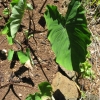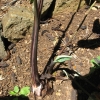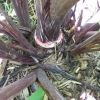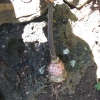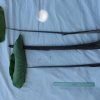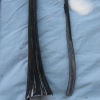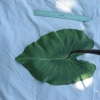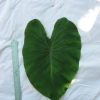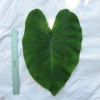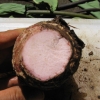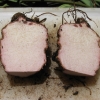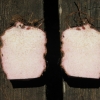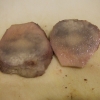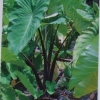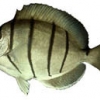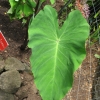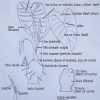Use As Food
Primarily as a table taro.
Distribution
Comparatively rare; grown under upland culture, where temperature of the water and land are cooler, or lo‘i (wetland) culture.
General Characteristics
Medium in height to tall, moderately spreading, maturing within 9 to 12 months, producing from 2 to 5 ‘ohā. Variety is dentified by yellowish-green to light red stripes on dark purplish background. According to J.K., Manini ‘Ōwali reproduces by sending out rhizomes, (runners) in addition to ‘ohā that grow from the corm.
Ha (Petiole)
80 to 100 cm. long, broad at kōhina (base) tapering to a narrow, often curved apex, dark purple with yellowish green, light red, or sometimes quite indistinct stripes, pink to whitish at edge, a brilliant reddish-purple ring at kōhina (base) with lilac-pink for 1 to 2 cm. above the base.
Lau or Lu'au(Leaf Blade)
50 to 60 cm. long, 35 to 40 cm. wide, 40 to 45 cm. from tip to base of sinus (māwae), arrow head shaped, firm-chartaceous (paper like), dark green with bluish cast; margins wave-like (undulate) piko purple; veins purple on lower surface; round leaf section (lobes) acute with deep, narrow lihi māwae (sinus).
'I'o kalo (Corm)
Flesh white with pinkish tinge especially near the top (apex), the fibers yellowish; skin lilac-pink with purple along leaf scars.
Pua (Flower)
Hā (peduncle) purplish-black or striped with purplish-black and yellowish-green or light red; flower cover (spathe) 26 to 30 cm, long the lower tubular portion 4.5 to 5.5 cm, long, striped light green and purple with reddish-purple at kōhina (base) and constriction (skinny part of flower), the upper portion deep yellow or orange, sometimes with purplish margins, tightly rolled, open near constriction (skinny part of flower) at maturity; spadix (spike of flower) 10 to 11 cm. long, the sterile appendage (tip of flower's spike) 11 to 12 mm. long.

